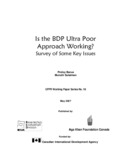Is the BDP ultra-poor approach working? Survey of some key issues

View/
Date
2007-05Publisher
BRAC Research and Evaluation Division and Aga Khan Foundation CanadaMetadata
Show full item recordAbstract
Though BRAC’s CFPR/TUP is the specialized program for the ultra-poor, it is observed that a good portion of its microfinance clients are also very poor and require special attention. Moreover, some of the poorer households from the community can be served through the mainstream BRAC Development Program (BDP) of which microfinance is the major part. To serve this specific group of microfinance participants and equally poor non-participants, CFPR/ TUP includes a model called ‘BDP ultra-poor’. The key components of the BDP ultra-poor program are training on income-generating activities (IGA) and provision of microcredit along with some other non-financial services. The objectives of this paper are to assess the knowledge retention on IGA training and to explore the quality of participation in financial and non-financial services by the BDP ultra-poor. We found that participants’ engagement in the IGA, their self-interest, training settings and the number of training participants have a strong association with the level of knowledge retention. The quality of microfinance participation of BDP ultra-poor is encouraging in terms of increasing their regularity of microfinance involvement. The borrower member ratio of the BDP ultra-poor who were recruited in 2003 is now over 85%, which is the industry standard. Such high borrower member ratio results from regular borrowing of the members, a reflection of their quality of participation.
